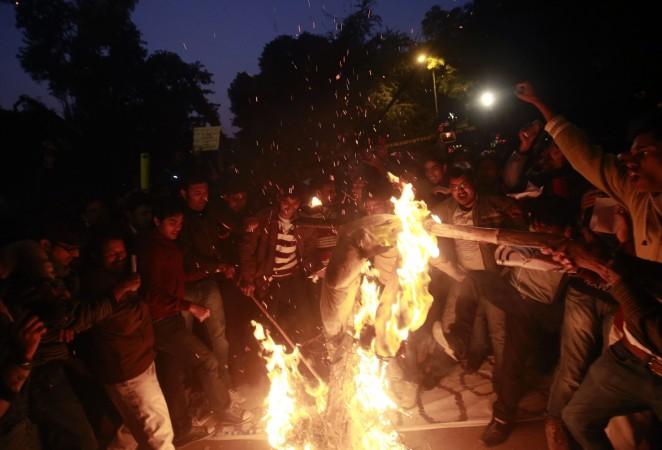
With less than 20 days to go for the second full-fledged Budget of the Narendra Modi government, the spotlight is firmly on Finance Minister Arun Jaitley when he presents Budget 2016 on Feb. 29. Even as the narrative is around economic growth, investment, bad loans of lenders and public spending, welfare issues — especially those concerning women — seem to be taking a back seat.
Of great interest would be the manner in which the Modi government deals with the Nirbhaya Fund, created in 2013 in the aftermath of the brutal gang rape of Jyoti Singh on Dec.16, 2012, in New Delhi, an incident that sparked nationwide outrage and protests.
The then Congress-led UPA government, despite allocating Rs 1,000 crore for the Fund in the 2013-14 Budget, faced flak for not utilising the money till the end of its tenure.
The Manmohan Singh government had envisaged installing panic buttons in cellphones, setting up CCTV cameras and GPS tracking in public transport and employing women conductors, among other measures, but most of these remain a pipe dream three years later.
"The UPA government sanctioned Rs 1,000 crore for the fund in 2013, and another Rs 1,000 crore was added to it in 2014. Perhaps the UPA government put in the money more to please voters at the time, but there was no real roadmap of how the funds would be spent. This money has remained with the Ministry of Finance," Ranjana Kumari, director at Centre for Social Research, an NGO that works for the safety and empowerment of women and girls in India, told Business Standard.
The Modi government, which came to power in May 2014, allocated Rs 1,000 crore to the fund in its first Budget presented in July 2014, taking the corpus to Rs 2,000 crore. A subsequent allocation of Rs 1,000 crore in the next Budget (Budget 2015) took the fund size to Rs 3,000 crore.
However, the utilisation of the fund for measures aimed at increasing safety of women is far below the money available with the Ministry of Women and Child Development (WCD), the nodal agency to handle the fund.
Of the Rs 3,000 crore, Rs 1,273.31 crore remained unused till April 2015, according to Women and Child Development Minister Maneka Gandhi, who was replying to a question in the Lok Sabha in back then.
Here's a look at the utilisation of the fund's corpus by the Modi government till December 2015, based on the ministry's update released on Dec. 18, 2015.
A review of utilisation of the fund reveals that Rs 712.07 crore had been allocated in 2015 for schemes to improve women's safety, according to data made available by the WCD Ministry.
Since the BJP-led government took over in 2014, the authority of managing the fund changed hands from the Ministry of Home Affairs (MHA) to the WCD Ministry.
The WCD Ministry is in charge of two projects, which are among the initiatives finalised in 2015 to which Rs 712.07 crore has been allocated.
One such project is the One Stop Centre for rape victims with a total project cost of Rs 18.58 crore, while the other is the universalisation of the Women's Helpline for Rs 69.49 crore. For the One Stop Centre, funds amounting to Rs 10.71 crore have been released, while Rs 13.92 crore has been given for the Women's Helpline to states and UTs.
The One Stop Centre is designed to allow the victim to register FIR, seek legal help and medical help as well as counselling.
Rs 200 crore will be allocated from the fund, under a sub-fund called Central Victim Compensation Fund (CVCF), for supporting state and UT administrations to implement the Victim Compensation Scheme, and Rs 324 crore for Investigative Units for Crimes Against Women in all police districts of the country, both under the MHA.
The CVCF aids victims of sexual crimes, acid attacks and human trafficking, an MHA statement said.
Another agency to deal specifically with human trafficking victims, called the Organised Crime Investigation Agency (OCIA), under both the WCD Ministry and the MHA, has been ordered by the Supreme Court to be operational by Dec. 1, 2016, and will be given Rs 100 crore.
In 2014-15 fiscal, the BJP-led NDA government had released Rs 150 crore for "schemes on backend integration of distress signal from victims with mobile vans and control rooms" and Rs 50 crore for the safety of women using public road transport, a statement said. The total allocation for the projects is Rs 1,405 crore and Rs 321.69 crore, respectively. The distress emergency response system was scrapped in January 2016. However, if reports are to be believed, it could make a comeback in Budget 2016.
The OCIA will get a fresh allocation from the remaining Rs. 1,273.31 crore, reducing the unutilised fund amount to Rs. 1,173.31.












